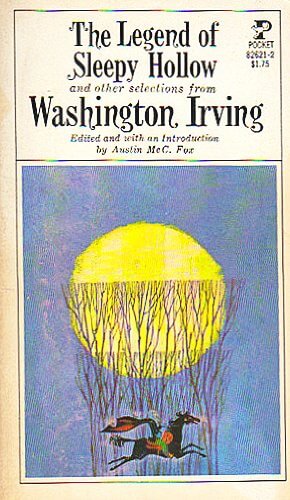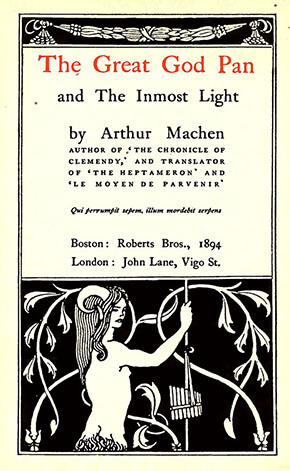I put out a call on Facebook for classic horror books to review, and I ended up picking two short stories: Washington Irving’s “The Legend of Sleepy Hollow” and Arthur Machen’s “The Great God Pan”.
“The Legend of Sleepy Hollow”
Certain it is, the place still continues under the sway of some witching power, that holds a spell over the minds of the good people, causing them to walk in a continual reverie. They are given to all kinds of marvellous beliefs, are subject to trances and visions, and frequently see strange sights, and hear music and voices in the air.
The image of Ichabod Crane fleeing for his life from a headless horseman carrying a flaming jack-o-lantern is probably one of the most recognizable images of classic Halloween stories. So it’s a little surprising when reading the source material that almost two thirds of the story is less about the ghosts of Sleepy Hollow and more about the traveling schoolteacher Ichabod and his fairly idyllic life there.
As a teenager, Washington Irving traveled quite a bit along the Hudson Rivier – including the real life town of Sleepy Hollow – so he spends a lot of time describing the people, the food, and most especially the scenery in loving detail. Every other page has some beautifully rendered image of life in the high hills in the American Northeast.
His stronghold was situated on the banks of the Hudson, in one of those green, sheltered, fertile nooks in which the Dutch farmers are so fond of nesting. A great elm-tree spread its branches over it; at the foot of which bubbled up a spring of the softest and sweetest water, in a little well, formed of a barrel; and then stole sparkling away through the grass, to a neighboring brook, that bubbled along among alders and dwarf willows.
Irving describes the characters with as much detail, and a lot of gentle humor. No one in this novella comes across as particularly heroic. Katrina Van Tassel, the object of Ichabod’s affections, is kind of a tease. Ichabod’s rival Brom Van Brunt is kind of a thug, although a sort of charming one. And Ichabod himself…well he’s not actually a bad person at all. He’s just fixated on food to the point where everything he does and even the way he treats his students is calculated on how quickly he can get a big meal out of someone. He also decides pretty quickly that being in love with Katrina means they’re guaranteed to be married soon, and he quickly gets lost in fantasizing about what an amazing life that will be, including getting to kick wandering schoolteachers to the curb the minute they get annoying.

What gets Ichabod in the most trouble though, is his fascination with ghost stories.
But if there was pleasure in all this, while snugly cuddling in the chimney-corner of a chamber that was all of a ruddy glow from the cracking wood-fire, and where, of course, no spectre dared to show his face, it was dearly purchased by the terrors of his subsequent walk homewards.
The midnight chase of by the Headless Horseman through the woods is iconic, but Ichabod had done most of the work of scaring himself even before the Horseman makes his appearance. Irving has a lot to say about the power of stories: the way they fascinate Ichabod in the daytime and then scare him out of his wits at night, and the way they shape historical events like the Revolutionary War into monsters that wander the night years or decades later.
And of course there’s the fact that the residents of Sleepy Hollow embrace their folklore so tightly that they won’t accept any explanation for Ichabod’s disappearance that isn’t supernatural, taking an everyday story of an embarrassed schoolteacher, a rejected marriage proposal, and a cruel prank, and turning it into a story that they’ll be telling their own versions of for years.
In that light I think Washington Irving would be amused at what his own story has been turned into throughout the years. Adaptations have cast Ichabod as a villain, or a romantic lead, or Johnny Depp as a dorky detecti-scientist. Oddly enough, the adaptation that I think comes closest to the original story is the Disney version. Yes, the company that gave The Hunchback of Notre Dame a happy ending and had the Little Mermaid marry the prince actually managed to get the story for The Legend of Sleepy Hollow right. The tone’s completely wrong (big-band swing tunes, ick) but the basic details are there, right down to the fact that Ichabod was obviously more in love with Katrina’s money than he ever was with Katrina herself.
“The Great God Pan”
Such forces cannot be named, cannot be spoken, cannot be imagined except under a veil and a symbol, a symbol to the most of us appearing a quaint, poetic fancy, to some a foolish tale.
From folktales being created out of real events, we move on to the idea that stories, and mythology, and religion, are symbols that humans create because the reality hiding just underneath what we can see is too horrible to describe.
Arthur Machen’s “The Great God Pan” was published more than seventy years after “The Legend of Sleepy Hollow”, but in many ways it feels much older. It’s been described as horror, Gothic fantasy, even a very early example of sci-fi (mostly because of the “mad scientist” in the first chapter). It’s a very weird story, something which tarnished the author’s reputation from all the people screaming about “sexual impropriety” and “a dangerous threat to the entire British public”. (All the fuss lead to the book being even more popular, so one would hope the critics literally died mad about it.)
The story starts with Dr. Raymond conducting an experiment with his friend Clarke as witness. The experiment involves a little minor brain surgery on Raymond’s young ward Mary (“ward” here interpreted as “property”, and treated as such), which will allow Mary to look behind the shadows of our world and into the “real” world, or what ancient civilizations call “seeing the great god Pan”.
Dr. Raymond is a little like Dr. Frankenstein, in that he has an idea and decides to run with it, not really thinking about what would happen if it goes wrong. Which it does. Badly.
We jump to several years in the future when the fallout of the experiment starts to become obvious. Strange things are happening; old friends show up penniless and mostly insane before dying miserably. Wealthy, happy men commit suicide for no reason. An artist dies of an unnamed illness just after sending his acquaintance a packet of drawings that are frightening in a way that’s impossible to explain.

The figures of Fauns and Stayrs and Aegipans danced before his eyes, the darkness of the thicket, the dance on the mountain-top, the scenes by lonely shores, in green vineyards, by rocks and desert places, passed before him: a world before which the human soul seemed to shrink back and shudder.
The point of view switches from person to person, several different storylines circling around one central mystery. Machen has an interesting method for describing the indescribable: he skips over it completely, sometimes stopping in the middle of a story as someone slams closed a notebook and refuses to read anymore, remembering a nightmare that the reader doesn’t get to see, and trying to get everyone else to just leave it alone.
Throw the portrait into the fire, blot out the story from your mind. Never give it another thought, Villiers, or you will be sorry.
There’s more in this story that isn’t told than is, from the horrors in the paintings, or the remembrances of what happened to a young woman named Rachel right before she disappeared, or all of the…things that a mysterious woman is doing with men right before they go home to commit suicide. Even the final confrontation is told in fragments and broken sentences by someone who wasn’t even there when it happened. It’s frustrating sometimes, but it also gets into your head as it makes you try to imagine what it is that was so terrifying to everyone involved. I can definitely see how Machen inspired writers like HP Lovecraft and Stephen King. King mentions “The Great God Pan” specifically in his author’s notes for his story “N”, which remains one of my favorite example of the trope where our world is a thin skin over an unknowable, but still horrifying, reality.